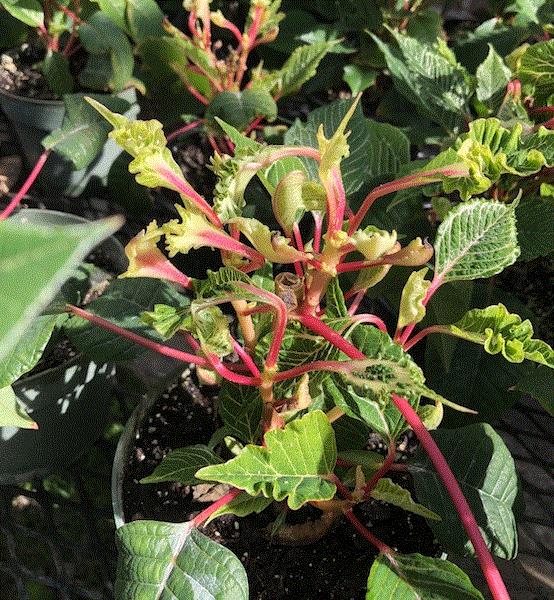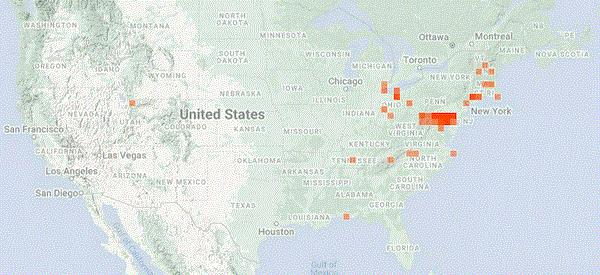What the ... ?
I said it many times in this newsletter and my presentations at conferences or workshops that I see plants as bug food. That’s no joke, but I think most horticulturists and plant lovers thought that was funny when I said it. For a plant lover, how can you not grow plants to be beautiful? Alas, I’m an entomologist first.
Although I don’t think I can grow beautiful plants, or at least not beautiful enough to compete in the marketplace, my poinsettia crop (Prestige Red) this year has been rather embarrassing. Have a look at the picture below and see for yourself. The problem has gotten worse as the season progresses.

What do you think is causing the problem?
I don’t have an answer, actually, so don’t look for one at the end of this newsletter. Instead, I’m going to outsource the diagnosis of this problem to y’all. I have a suspect, but I’ll keep the suspense for now. Some hints: I didn’t find any thrips or broad mites, and I didn’t use any herbicide or plant growth regulators.
Let’s see what y’all think is going on—think of this as audience participation. Send me an email and let me know what you think. Are the plants cursed? Did the plants give up after knowing their ultimate fate? Or do they just hate me this year?

Finishing Poinsettias
If you're not an utterly rubbish entomologist pretending to be a horticulturist, many of y’all are probably finishing up your poinsettia crop at this time of the year. I’ll direct you to one of my newsletters from a year ago on some of the major pest issues you may encounter when finishing up a poinsettia crop.
Several insect and mite pests can be problematic in a poinsettia crop, but hopefully, you have a pretty clean crop during bract formation or just before shipping because your chemical and/or biological control program has suppressed the population. Whitefly is perhaps the most critical pest of poinsettias just before shipping. Based on some of the data I've seen, products that have a good and quick knockdown of whitefly population are Avid (abamectin), TriStar (acetamiprid), Safari (dinotefuran), Flagship (thiamethoxam), pyrifluquinazon (Rycar), afidopyropen (Ventigra) and Sanmite (pyridaben).
Disease management can be trickier during the finishing stage. Again, hopefully, enough has been done during the growing stages to minimize disease incidence at the end of the crop cycle, especially for difficult disease issues like stem and root rots caused by Pythium and Rhizoctonia. Pythium can rear its ugly head if you overfertilize, which causes salt stress and root damage. Infected plants should be removed immediately and the fertilization schedule should be modified. A fungicide drench, such as with Segway O (cyazofamid) or Subdue Maxx (mefenoxam), may be needed to prevent the spread to other plants in the crop.
Environmental control is critical in avoiding or minimizing Botrytis (bract edge burn) and powdery mildew problems. Don’t panic if Botrytis or powdery mildew shows up because there are a good number of effective fungicides for these diseases. Mural (azoxystrobin + benzovindiflupyr), Palladium (cyprodinil + fludioxonil), Decree (fenhexamid), Medallion (fludioxonil), Astun (isofetamid), Milstop (potassium bicarbonate) and Pageant Intrinsic (pyraclostrobin + boscalid) are reported to be bract safe.

Valent BioSciences is in on Biostimulants
Valent BioSciences announced last week that it's launched its new biostimulant operating unit to sell biostimulants directly to its customers in the United States.
The company currently has a line of products under the MycoApply brand, such as MycoApply Endo for uses on turfgrasses and ornamental plants. Other biostimulant products also include Symvado and Proliant for various crops. These products contain a mix of multiple arbuscular mycorrhizal fungal (AMF) species. Valent BioSciences touted the ability of AMF to form beneficial relationships with crop plants to increase root mass, improve water acquisition, increase nutrient uptake efficacy and improve soil structure.

Valent BioSciences has been building its biostimulant business for some time. The company acquired Mycorrhizal Applications, the manufacturer of MycoApply products, in 2014. The new biostimulant unit was established in February 2022.
Valent BioSciences’ new biostimulant unit will help its customers better adopt and utilize biostimulants in their crop production systems by providing technical support and digital tools. Visit Valent BioSciences’ website for more information about its offering of biostimulants, growth regulators and biopesticides.

SLF Found in Texas?
Some of you probably heard about the finding of spotted lanternfly in Texas in the past two weeks, such as from this news report. Well, this has sort of become a mystery.
This month, an iNaturalist user sighted a spotted lanternfly near Houston, Texas. For those of you who aren’t familiar with iNaturalist, this is a mobile phone app that allows anyone with the app to report or document the presence of plants, bugs, birds, etc. in backyards, during a walk or anywhere around them. The app also has the curious side benefit of detecting invasive species before the departments of agriculture even know about the invasion. It was an iNaturalist report in 2018 that alerted the Canadian authority to the presence and establishment of boxtree moth in Ontario.
The report of spotted lanternfly in iNaturalist has put inspectors from USDA-APHIS, the Texas Department of Agriculture and personnel from Texas A&M AgriLife Extension on high alert. Inspectors were out in the area where the sighting was reported, but didn’t find any spotted lanternfly. The authorities were not sure if the sighted spotted lanternfly was a hitchhiker or a member of an established, but yet undetected, population. They were also trying to contact the person who made the report.
Here's where things got a little curious. If you're looking for the AgriLife blog post linked by the news article cited above, you won't find it. If you go to iNaturalist, you'll see that Texas isn't marked as having a record. So were the blog post and the report on iNaturalist removed? Is this a case of a hoax or misreporting?

Reported locations of spotted lanternfly on iNaturalist as of October 24, 2022.
Now, don't get into any conspiracy theories—let's just wait and see if the establishment of a spotted lanternfly population can be confirmed in Texas. I’m sure if spotted lanternflies become established in Houston, Houstonians will be stomping on them with as much vigor as New Jerseyans.

Webinars for the Next Two Weeks
I want to introduce to you four educational events scheduled for late October through early November.
The first one is an upcoming GrowerTalks webinar on October 27 at 1:00 p.m. Eastern/Noon Central. Chris Fifo, Darwin Perennials' in-house expert, will chat about "3 1/2 Steps to Overwintering Perennials." You'll learn about the best ways to choose the varieties, structure and culture methods for overwintering your perennials. Click here to register.
The second one is a series of three webinars hosted by the Northeast Greenhouse Conference and Expo on Wednesdays at 11:45 a.m. to 1:00 p.m. Eastern starting on October 25. The first webinar is by Brian Whipker of North Carolina State University called “Plant Diagnostic Detective: Focus on Abiotic Disorder.” Brian will chat about how to identify potential abiotic problems in greenhouse crops.
On November 2, I’ll talk about how pesticide resistance arises in a pest population and how to develop a pesticide rotation program.
On November 9, Margery Daughtrey of Cornell University will cover disease management. Margery will talk about diseases caused by fungi, bacteria, nematodes and viruses, and what you can do to avoid and manage these diseases.
Registration is $25 per webinar or $65 for all three. Click here to register.

The third webinar is part of Horticultural Research Institute’s tHRIve web series. At 11:00 a.m. Eastern on November 3, Robert Geneve of the University of Kentucky will present the webinar, “Smart Plants—Magical Interactions Between Flowers and Their Pollinators.” Robert will talk in detail about flower morphology and how that helps attract pollinators and shapes the interactions between plants and pollinators. The webinar is free. Click here to register.
Last, but not least, is a free webinar hosted by Penn State Extension as part of its Pennsylvania Forest Seminar series. Emily Rojik of Penn State Extension will provide a webinar, titled “Dormant-Season Invasive Plant Management in Forests,” on November 8. There are two sessions to register for—one starts at noon and the other at 7:00 p.m. Eastern. Emily will talk about the types of plants that can be controlled during dormant season, control methods and techniques, and herbicides that can be used for dormant-season management.
This is a free webinar, but a fee may be charged if you choose to receive educational credits from the Society of American Foresters, State Coordinated Licensed or Registered Foresters, and Sustainable Forestry Initiative. Click here to register.




See y'all later!

JC Chong
Professor of Entomology at Clemson University
This e-mail received by 27,781 subscribers like you!
If you're interested in advertising on PestTalks contact Kim Brown ASAP!